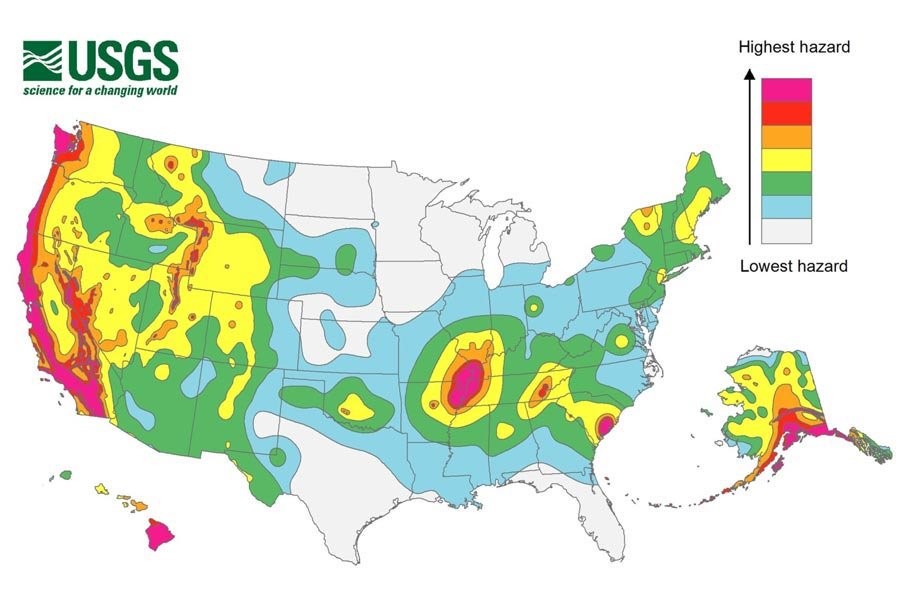Safe Places Report No. 7:
This is the first of several reports where I will show you how to avoid or minimize risk from natural threats when selecting your new Safe Place.
We each have our individual assessments of the natural threats we fear the most. For me, those are earthquakes and tornadoes, because they can strike with very little or no warning and you can lose all or most of your material possessions (including your home and your furnishings in it, and your automobiles), not to mention the potential for loss of life. With advance planning, though, you can choose an area for your new home where earthquake risk is nonexistent or minimal. Even if you must live in an earthquake-prone area, there are steps you can take to protect your life and your property as much as possible.
California comes immediately to mind when we think of earthquakes, and indeed California accounts for two-thirds of our nation’s earthquake risk. But all of the Pacific coast is at risk, from California to Alaska and west to the islands of Hawaii. You will want to check on earthquake risk for any location in the western half of the U.S., including (recently) Oklahoma. Even in the eastern half of the nation, there are very seismically active areas—such as the dangerous New Madrid seismic zone (around the confluence of Missouri, Kentucky, southern Illinois, Arkansas, and Tennessee) and the less dangerous Southern Appalachian Seismic Zone, stretching from northeastern Alabama to southwestern Virginia, and centering in eastern Tennessee.

A general overview of the 2014 USGS National Seismic Hazard Map, indicating the probability of earthquakes throughout the United States. (Source: US Geological Service)
Links to Helpful Sites
- U.S. Geological Survey: What are the earthquake hazards/risks where I live?
- Enter your state and find out.
- Seismic Safety Commission
- Some information is California-specific, but much is valuable no matter where you live—specifically “Protecting Your Family from Earthquakes: The Seven Steps to Earthquake Safety,” “The Homeowner’s Guide to Earthquake Safety,” and “The Commercial Property Owner’s Guide to Earthquake Safety.”
- Red Cross Earthquake Safety: Before, During, After
- What to do during an earthquake, and how to strengthen your home to prepare for an earthquake.
- FEMA: Earthquake Risk
- The Federal Emergency Management Agency’s earthquake risk management site.
- Fox News 2015: “New study suggests 42 states at risk for earthquakes”
- According to the new nationwide study by the U.S. Geological Survey: “The 8 states that did not have significant hazard levels are Florida, Iowa, Kansas, Louisiana, Michigan, Minnesota, North Dakota and Wisconsin. The 16 states at highest risk are Alaska, Arkansas, California, Hawaii, Idaho, Illinois, Kentucky, Missouri, Montana, Nevada, Oregon, South Carolina, Tennessee, Utah, Washington, and Wyoming.”
Links to Some Geographically Specific Sites
- California
- California Earthquake Authority
- Enter your county name to understand the earthquake risk where you live. Also information on earthquake insurance. Note: This is not a state government site, and appears to be an industry site promoting earthquake insurance.
- California Emergency Preparedness Office
- Earthquake planning, preparedness, and practicing.
- Earthquake Country Alliance
- A valuable assortment of 10 links that provide California hazard information, fault line maps, and survival hints for when one hits your area.
- Seismic Safety Commission
- California-specific information and three valuable reports—“Protecting Your Family from Earthquakes: The Seven Steps to Earthquake Safety,” “The
- Homeowner’s Guide to Earthquake Safety,” and “The Commercial Property Owner’s Guide to Earthquake Safety.” Also available from U.S. Geological Survey: Preparedness
- California Earthquake Authority
- Washington and Oregon (Pacific Northwest)
- Washington Department of Natural Resources: Earthquakes and Faults
- Fault line maps and what to do before, during, and after.
- Scientific American: “Where the Pacific Northwest’s ‘Big One’ Is More Likely to Strike”
- For the more scientifically oriented: A general prediction for where, but not when.
- Washington Department of Natural Resources: Earthquakes and Faults
- Alaska
- University of Alaska Fairbanks: Alaska Earthquake Center
- The areas at greatest risk are the Aleutian Islands and the mainland from the Anchorage area north to around Fairbanks. The Inside Passage is a secondary risk area.
- University of Alaska Fairbanks: Alaska Earthquake Center
- Oklahoma-Texas
- Houston Chronicle: “USGS forecasts high earthquake risk linked to oil and gas activity”
- Controversial report says risks in Oklahoma City and Dallas-Fort Worth areas are now on the same level as California. But the Dallas director of emergency management says the risk of a big one is “less than 1 percent”: USGS Report: North Texas Earthquake Risk
- Houston Chronicle: “USGS forecasts high earthquake risk linked to oil and gas activity”
- Utah
- Utah Geological Survey April 28, 2020 Press Release
- “New study provides crucial information for reducing earthquake risk in densely populated and rapidly developing areas adjacent to active Wasatch Front faults” (Salt Lake City and eastern Utah).
- Utah Geological Survey: Hazard Maps
- Statewide and county maps.
- Utah Geological Survey April 28, 2020 Press Release
- Idaho
- Idaho Geological Survey and others: “Putting down roots in earthquake county”
- Earthquake risk is generally low in this popular survivalist state, but this is your handbook for earthquakes in Idaho, with regional reports and 7 steps to earthquake safety.
- Idaho Geological Survey and others: “Putting down roots in earthquake county”
- Arkansas
- Arkansas Geological Survey: Earthquakes
- Maps and information centering on the New Madrid seismic zone.
- Arkansas Geological Survey: Earthquakes
- South Carolina
- The State: “When’s the next big one? Agency scanning below SC surface to help predict earthquakes”
- Recent seismic activity has been low-level, but the Low Country is considered to be at elevated risk compared to the rest of the Southeast.
- The State: “When’s the next big one? Agency scanning below SC surface to help predict earthquakes”
Some Final Advice
If you relocate anywhere on the Pacific coast, check your property location’s susceptibility to tsunami damage, which would often follow under-the-ocean earthquake activity.
For information on natural threats, it is always a good idea to check with your relevant city, county, and state agencies—those involved with natural resources, emergency management, and such. Local real estate sources may not always be completely reliable in detailing risks, though you should let them know of your concerns and that you will be doing independent research on this.
And the links provided above are just a partial listing of what is available through a robust search engine like DuckDuckGo.com. If you find another site that you consider particularly useful, please email me with that information.
You Were Warned
The rain came down, the streams rose, and the winds blew and beat against that house; yet it did not fall, because it had its foundation on the rock. But everyone who hears these words of mine and does not put them into practice is like a foolish man who built his house on sand. The rain came down, the streams rose, and the winds blew and beat against that house, and it fell with a great crash.”
–Matthew 7:25-27
Go here for a listing of my previous Safe Places Reports.





